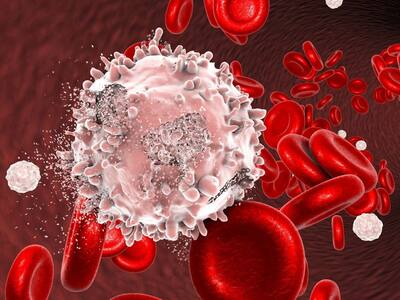Don’t Miss Out on the Latest Updates.
Subscribe to Our Newsletter Today!
Blood Cancer: What Are The Various Types And Treatments Available?

Blood cancer awareness month: What are the different kinds and therapies available in India?
Blood cancer awareness month 2022: Blood is a vital organ and the body's primary transport system. It carries oxygen and nutrients to the various tissues and carries away toxins and waste products to our kidneys, only to be removed from the body. Plasma is its liquid component in which the blood cells, including red blood cells, white blood cells, and platelets, are suspended. Blood cells develop from stem cells in spongy tissue inside the bones known as Bone marrow. It includes lymph nodes, lymphatic vessels, the spleen and the thymus gland. Blood cancers arise from blood cells, bone marrow or the lymphatic system. These can affect anyone regardless of race, age or gender. Dr Mitu Shrikhande, Senior Consultant- Haematology, Fortis Hospital Vasant Kunj, explains the three main types of blood cancers: Leukaemia, Lymphoma and Myeloma.
- Leukaemia:Leukemia originates from bone marrow cells. Due to the proliferative and survival advantage of the cancer cells, the leukemic cells outgrow the normal blood cells in numbers resulting in decreased number and function of the normal cells. This results in symptoms of anaemia and increased susceptibility to infections and bleeding.
- Leukaemia can be divided based on: 1. How fast they develop (Acute or Chronic). 2. Cell of origin Lymphoid or Myeloid). Acute types develop suddenly and can be life-threatening if not treated immediately. On the other hand, the Chronic type progress over a long period, and treatment is deferred till they are symptomatic in certain situations. Therefore, leukaemia can be Acute Lymphocytic Leukemia (ALL) or Chronic Myeloid Leukemia (CML).
- Lymphoma: Lymphomas originate in the lymphatic system. There are broadly two types, i.e. Non-Hodgkins Lymphoma & Hodgkins Lymphoma. Symptoms may include painless lumps in the armpit, neck and groin with or without unexplained persistent fever, weight loss and night sweats.
- Non-Hodgkins Lymphoma: This group comprises several subtypes. Broadly, these can be either. Indolent (slow-growing) or Aggressive (fast-growing). More than 80 % are a B-cell subtype, and the rest are T-cell or NK cell types. A few common subtypes include Diffuse Large B-cell Lymphoma, Follicular Lymphoma, Mantle cell Lymphoma, Anaplastic Large cell Lymphoma, Primary Cutaneous T-cell Lymphoma & Burkitt Lymphoma.
- Hodgkins Lymphoma: It's a potentially curable lymphoma with distinct histology. It is seen in both young adults and the elderly.
Treatment Options In Blood Cancer
DIAGNOSIS OF BLOOD CANCER IS NOT A DEATH SENTENCE.
Accurate diagnosis is imperative before formulating a treatment plan. Treatment may vary with diagnosis and include the following modalities alone, sequentially or in combination.
Also Read
- Active surveillance: It's generally advocated that we need to detect and treat cancers in their early stages to improve outcomes. However, in particular, in blood cancers like early stages of CLL and Low-grade Lymphomas, the asymptomatic disease can be observed, and treatment at the early asymptomatic stage does not improve the outcome. In addition, the condition can be quiescent for a long time, and treatment toxicity needs to be considered if there is no benefit of therapy in asymptomatic cases. Therefore, if necessary, these patients are observed closely and followed periodically through careful history, physical examination, blood tests, and imaging.
- Best supportive care, including transfusions of blood components: Blood component therapy and best supportive care as required are integral to the standard treatment protocols of all blood cancers. Elderly, frail patients with multiple comorbidities may not be candidates for aggressive treatment protocols. Instead, they may be offered only the best supportive care with blood components like Packed RBC or Platelet transfusions as and when required.
- Chemotherapy: Chemotherapy means administering chemicals or drugs to cause cell death. These can be administered through various routes depending on the drug used and the indication. For example, the multiple ways to treat blood cancers can be oral, intravenous or intrathecal. Their administration may require the insertion of central catheters or chemo ports.
- Radiation therapy: Radiotherapy is used in blood cancers for conditioning before curtain Transplants or to treat a solitary Plasmacytoma and in patients with residual disease after completion of planned chemotherapy cycles in cases of Lymphomas.
- Stem cell transplant involves replacing the recipient's diseased stem cells with healthy matched donor stem cells. The donor could be an HLA-matched sibling, a half-matched ( Haplo ) donor or Cord blood stem cells or a matched unrelated donor through a stem cell registry. Stem cell transplant involves collecting stem cells from a matched donor and transfusing them to the recipient after conditioning chemotherapy administration.
- Targeted therapy: Targeted therapy involves the administration of drugs which do not lead to
blind cell kill like chemotherapy but inhibit molecular pathways integral to cancer cell growth and survival. These are specific to cancer cells and have fewer off-target side effects. They are well tolerated and may be administered alone or in combination with chemotherapy through oral or intravenous routes. Unfortunately, not all cancers have a targeted treatment available. Drugs like Tyrosine kinase inhibitors have revolutionized the treatment of CML.
- Immunotherapy: Immunotherapy involves the administration of drugs which work by stimulating the body's immune system to fight against cancer. These include drugs like monoclonal antibodies and immune checkpoint inhibitors. Cancer vaccines work on the same principle. But unfortunately, there is no cancer vaccine for blood cancers at present.
- Cellular therapy: CAR-T therapy works by taking T cells from the body and genetically modifying them in a laboratory, and administering them back into the blood to enable them to kill cancer cells more vigorously. It is a form of cell-based gene therapy.
- Surgery: Surgery rarely has any therapeutic role in treating blood cancers. Procedures like lymph node biopsy are purely for diagnostic purposes. However, some hemato-oncological cases can present as surgical emergencies.


